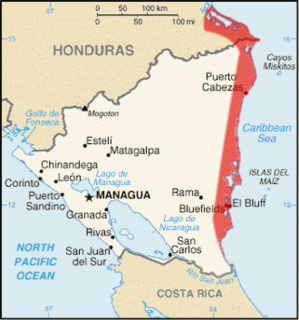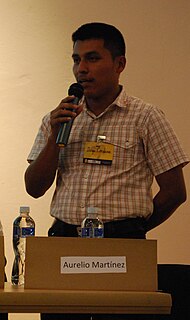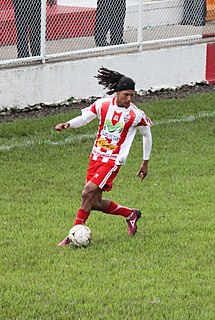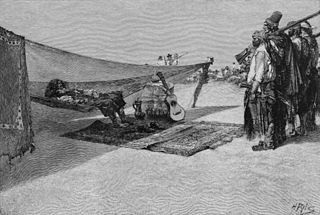Related Research Articles
According to the 2019 revision of the World Population Prospects, Nicaragua has a population of 6,465,501. Whites and Mestizos/Castizos combined make up about 86% of the population. The remainder of the Nicaraguan population is 9% Afro-Latino, and 5% Native American.

The Mosquito Coast, also known as the Miskito Coast and the Miskito Kingdom, historically included the kingdom's fluctuating area along the eastern coast of present-day Nicaragua and Honduras. It formed part of the Western Caribbean Zone. It was named after the local Miskito Amerindians and was long dominated by British interests. The Mosquito Coast was incorporated into Nicaragua in 1894; however, in 1960, the northern part was granted to Honduras by the International Court of Justice.

Zambo and cafuzo are racial terms historically used in the Casta caste class system of the Spanish and Portuguese empires. Occasionally in the 21st century, the term is used in the Americas to refer to persons who are of mixed African and Amerindian ancestry.. Historically, the racial cross between enslaved Africans and Amerindians was referred to as a zambayga, then zambo, then sambo.

The Miskito are an indigenous ethnic group in Central America, of whom many are mixed race. In the northern end of their territory, the people are primarily of African-Native American ancestry; others are of mixed African-Native American and English descent. Their territory extends from Cape Camarón, Honduras, to Río Grande de Matagalpa, Nicaragua, along the Mosquito Coast, in the Western Caribbean Zone. Their population is estimated at 180,000 people as of 2016.
Andrew Hendy was appointed honorary chief of the Miskito in 1894 by Zelaya's government. Andrew was a sambo-miskito, cousin of the last Miskito chief Robert Henry Clarence of Miskito Nation. Andrew's appointment was rejected by Sam Pitts, a Tawira Miskito, who started a war that lasted until 1907, when Sam was killed by Zelayan troops.

The Misumalpan languages are a small family of languages spoken by indigenous peoples on the east coast of Nicaragua and nearby areas. The name "Misumalpan" was devised by John Alden Mason and is composed of syllables from the names of the family's three members Miskito, Sumo languages and Matagalpan. It was first recognized by Walter Lehmann in 1920. While all the languages of the Matagalpan branch are now extinct, the Miskito and Sumu languages are alive and well: Miskito has almost 200,000 speakers and serves as a second language for speakers of other Indian languages on the Mosquito Coast. According to Hale, most speakers of Sumu also speak Miskito.
Mískito Coast Creole or Nicaragua Creole English is an English-based creole language spoken in coastal Nicaraguan region of Mosquito Coast on the Caribbean Sea; its approximately 30,000 speakers are spread over a number of small villages. The region is today administratively separated into two autonomous regions: North Caribbean Coast and South Caribbean Coast. Mosquito is the nickname that is given to the region and earlier residents by early Europeans who visited and settled in the area. The term "Miskito" is now more commonly used to refer to both the people and the language.

Miskito is a Misumalpan language spoken by the Miskito people in northeastern Nicaragua, especially in the North Caribbean Coast Autonomous Region, and in eastern Honduras.

The Mayangna are a people who live on the eastern coasts of Nicaragua and Honduras, an area commonly known as the Mosquito Coast. Their preferred autonym is Mayangna, as the name "Sumo" is a derogatory name historically used by the Miskito people. Their culture is closer to that of the indigenous peoples of Costa Rica, Panama, and Colombia than to the Mesoamerican cultures to the north. The Mayangna inhabited much of the Mosquito Coast in the 16th century. Since then, they have become more marginalized following the emergence of the Miskito as a regional power.
Rama Cay Creole is a Creole language spoken by some 800 to 900 people on the island of Rama Cay in eastern Nicaragua. It is based on Miskito Coast Creole with additional elements of the Chibchan language Rama and purportedly some elements of English spoken with a German accent. The creolization of the language is supposed to have happened when Moravian missionaries who were native Germans but preached in English encouraged the Rama-speaking population of the island to shift to English.
The official language of Nicaragua is Spanish; however, Nicaraguans on the Caribbean coast speak indigenous languages and also English. The communities located on the Caribbean coast also have access to education in their native languages. Additionally, Nicaragua has four extinct indigenous languages.
The Western Caribbean Zone is a region consisting of the Caribbean coasts of Central America, from Yucatán in Mexico to northern Colombia, and also the islands west of Jamaica. The zone emerged in the late sixteenth century as the Spanish failed to completely conquer many sections of the coast, and northern European powers supported opposition to Spain, sometimes through alliances with local powers.
The Miskitu are an ethnic group of mixed cultural ancestry occupying a portion of the Caribbean coast of Central America known as the Mosquito Coast region. Although older records, beginning with Spanish documents of the early 18th century, refer to the group as "Mosquitos Zambos", modern ethnographic terminology uses the term “Miskito”.
Miskito may refer to:
George I was king of the Miskito from 1755 to 1776. He was brother of King Edward and son of Jeremy II and was chosen king because Jeremy II's eldest son was still too young to rule.
Rafaela de Herrera y Torreynosa (1742–1805) was a Nicaraguan heroine. She is considered a national heroine of Nicaragua, due to her actions in the defense of the Fortress of the Immaculate Conception during the Battle for the Río San Juan de Nicaragua in 1762.

The Battle for the Río San Juan de Nicaragua was one of several important battles that took place during the Anglo-Spanish War, a subconflict of the Seven Years' War, which lasted from December 1761 until February 1763. The conflict, which took place in July–August 1762, began when William Lyttelton, the British governor and commander-in-chief of Jamaica, sent a naval expedition to Nicaragua with the primary objective of capturing the town of Granada.

Afro-Nicaraguans are Nicaraguans of African descent in Nicaragua. They make up 9% of the population and they're the largest group of African descent in in Central America. Numbering almost 600,000, according to the CIA factbook (2011), they primarily live on the southeastern coast, the Mosquito Coast, Bluefields and Managua. Creoles are from the Anglo-Caribbean and speak a dialect of Jamaican patois known as Miskito Coast Creole. Nicaragua also has a Garifuna population.

Between 1665 and 1857, Caribbean pirates and filibusters operated in Lake Nicaragua and the surrounding shores. The Spanish city of Granada, located on the lake, was an important trading centre for much of its early history so it was a prime target for pirates such as Henry Morgan and freebooters like William Walker.
References
- ↑ "Miskito: Tawira language." Global Recordings. (retrieved 2 July 2011)
- ↑ Karl Offen, "The Sambu and Tawira Miskito: Origins and Geography of Intra-Miskitu Differentiation in Eastern Nicaragua and Honduras," Ethnohistory 49/2 (2002): 319-72.